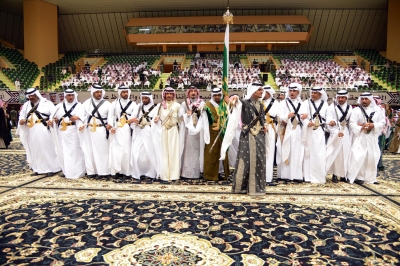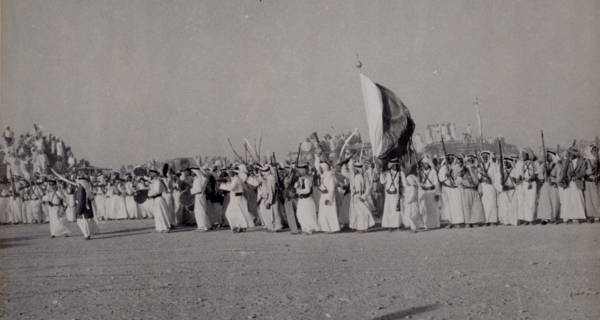
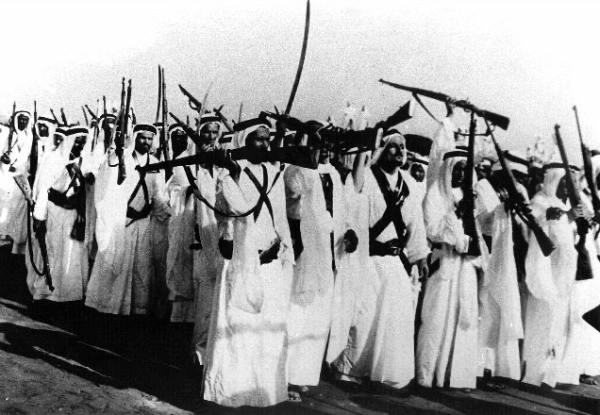
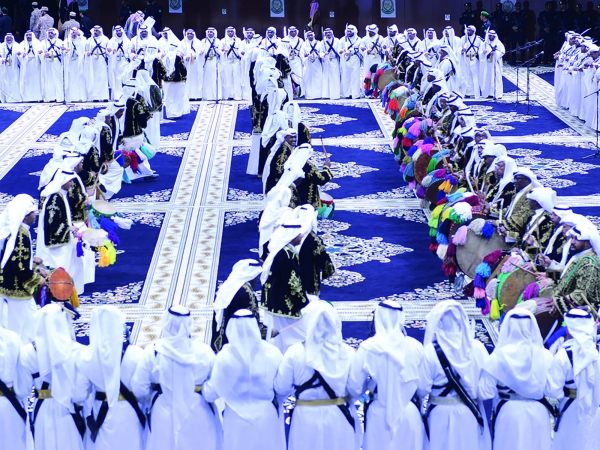
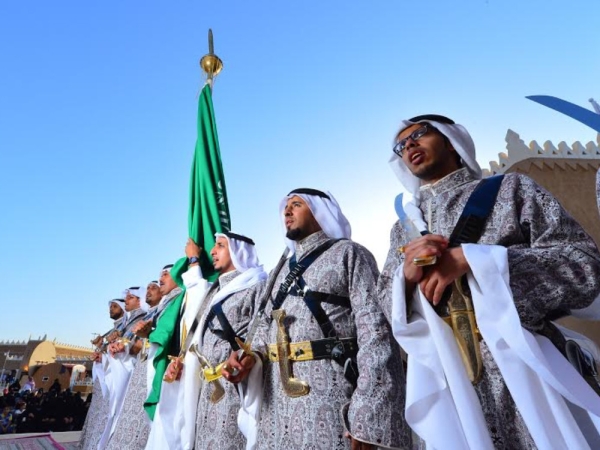
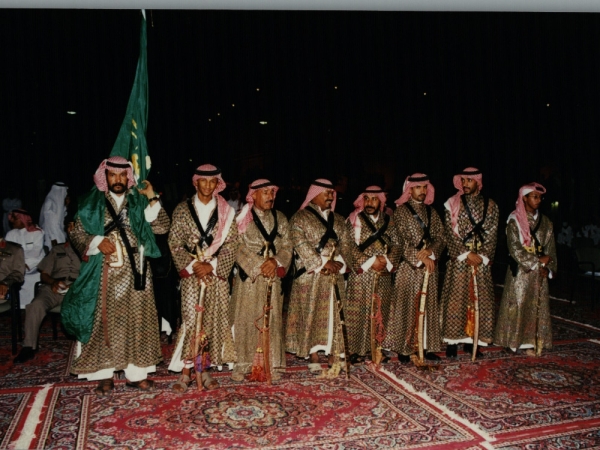
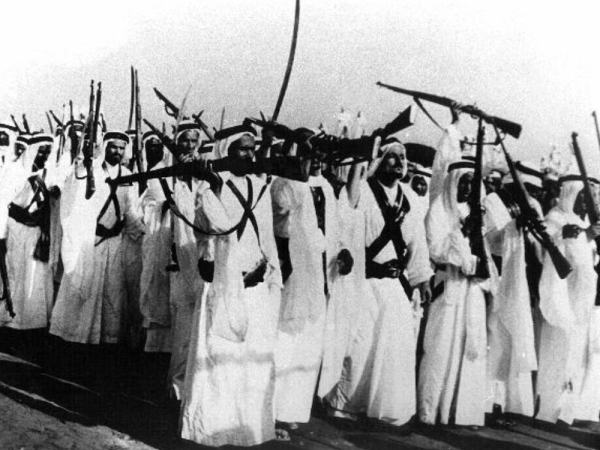
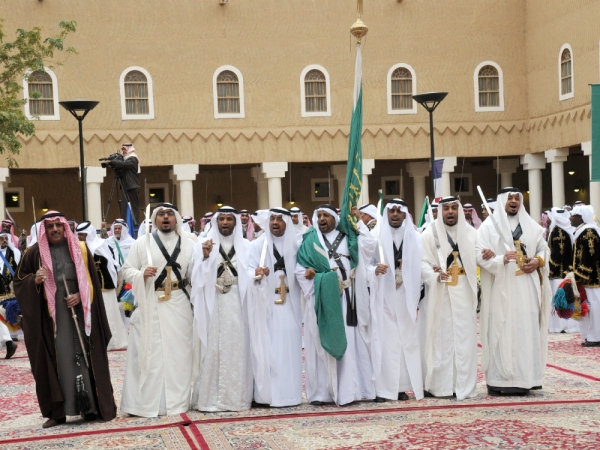
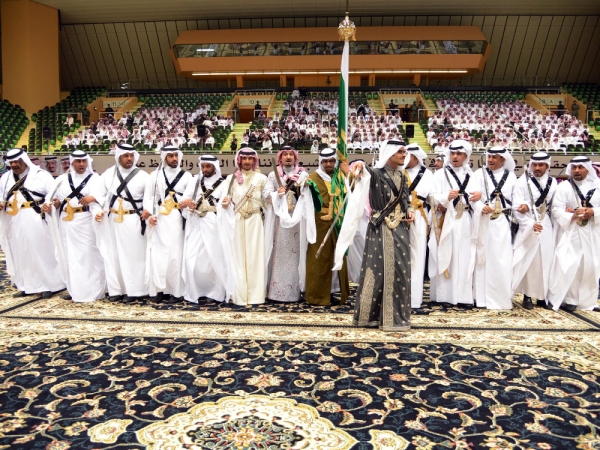
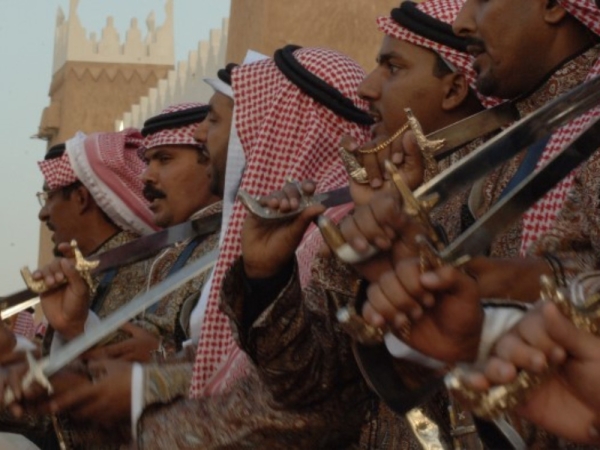
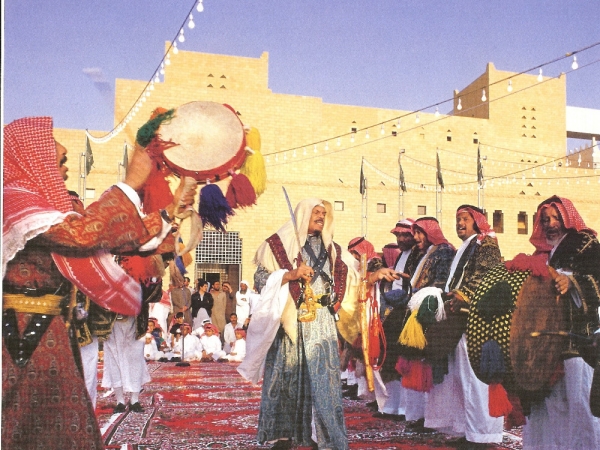
The Saudi Ardah is a traditional sword dance performed at celebrations, social events, and holidays in the Kingdom of Saudi Arabia. It is locally known as al-Ardah al-Najdiyah (Najdi Ardah Dance), it is an iconic performance art and symbolic weapon dance in the Kingdom. The Ardah also serves as an official protocol for special occasions and is performed to honor the presence of heads of state and visiting international delegations.
The art of the Saudi Ardah
Previously, the Ardah was performed as an announcement and preparation for war, serving as a motivation for courage and a reminder of strength and bravery, and as a renewal of loyalty to the leader and a pledge of support. With the establishment of security in the Kingdom, the Ardah has transformed into a kinetic performance expressing joy and is held on happy occasions. It is a masculine dance that relies on solemn collective movement, simulating ancient battles with the Muhawreb, knights, drums, flags, swords, and enthusiastic poetry, originally associated with the declaration of war. Over the ages, it has undergone some modifications and developments to appear in its current form.
The Saudi Ardah begins with the Hawrabah, which represents the opening and first call of the Ardah, chanted by a performer with a robust voice called the Muhawreb, starting from the musical maqam of al-Nawa. This is followed by the phase of Takhmir (large drums) and Tathlith (small drums), leading to al-Zamiya phase, which represents the conclusion of the Ardah with the recitation of the phrase Tahta Bayraq Sayidi Sama’an Wa Ta'a (Under the banner of my King, we heard and we obeyed). More than one line can perform the Saudi Ardah simultaneously and in any direction.
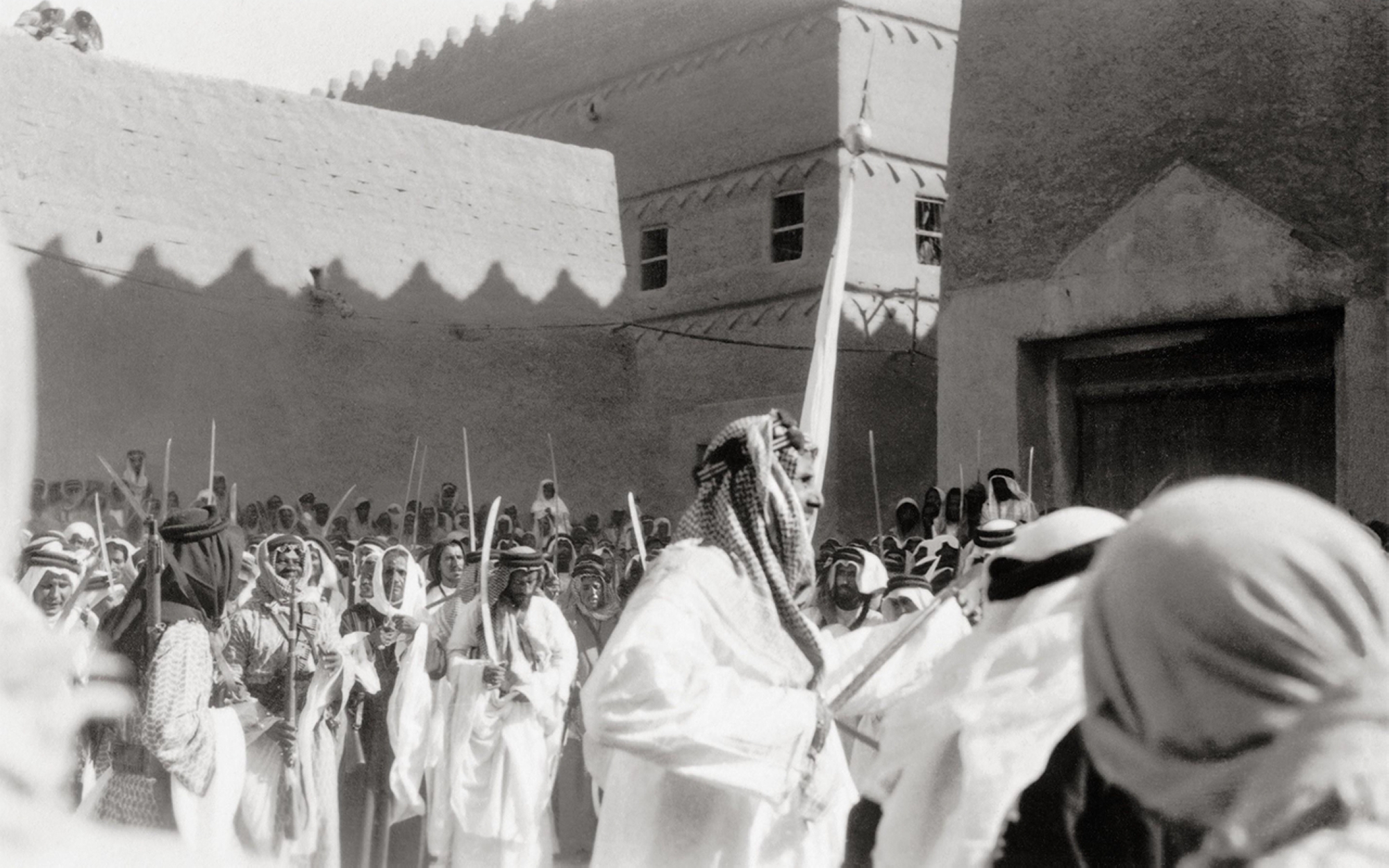
The history of the Saudi Ardah
The oldest text of the Ardah dance is what Ibn Ghannam mentioned in the events of the year 1764, when Imam Abdulaziz Bin Mohammed Bin Saud, while he was a commander of the armies during his father's era, took the army outside the walls of Diriyah and performed the art of the Ardah in front of the enemy's army.
The Ardah in the reign of King Abdulaziz
The Ardah was known as a war dance, where the Muhawreb would recite two or three verses that rouse courage, as a declaration of war and its first signal. It was present during the era of the Founding King Abdulaziz Bin Abdulrahman Al Saud in the wars and battles he fought on various fronts. The verses of the Ardah were expressive and truthfully reflective of the reality they were living in, ranging from pride and enthusiasm to displaying strength and endurance, showcasing equipment and armament, and either declaring war or celebrating a victory. It is narrated that when King Abdulaziz intended to confront an opponent, he would designate a place to gather the warriors who would come chanting the Ardah songs as an announcement of their readiness and preparedness. He would lead them to the rhythm of drums and chants, carrying the banner, proudly boasting and exulting in his soldiers. Additionally, the Ardah was performed during times of victory and on festive occasions as a celebration of glory. History shows King Abdulaziz participating with his people in performing the Ardah on their occasions.
The Ardah in the reign of King Saud
The Ardah continued in the era of King Saud Bin Abdulaziz Al Saud in the same style, being performed in official celebrations and joyful occasions. King Saud participated in performing the Ardah since the time of his father. However, he added speed and agility to its performance. It is noted that he gave it special attention, encouraging its practice and celebration as it immortalizes the memory of the founding of the Kingdom, the memory of the founder, and the struggles he and his men endured to bring the Kingdom and its people to their current state.
The Ardah in the reign of King Faisal
The Ardah continued during the reign of King Faisal Bin Abdulaziz Al Saud, being performed in celebrations of festivals, occasions, and visits of delegations and state leaders. King Faisal was among the prominent performers of the Ardah. His performance was characterized by his steady and poised movements, proudly showcasing his stature and torso in his slow swaying to the left and right. During his reign, the traditions of the Ardah were meticulously preserved, such as chanting the Ardah songs, many of which he knew by heart. He also performed it during visits of state leaders, involving them in the performance and offering them his sword to execute some of the Ardah movements he taught them. They appreciated participating in this cultural heritage and took commemorative photos during its performance.
The Ardah in the reign of King Khalid
King Khalid Bin Abdulaziz Al Saud continued the practice of his father, King Abdulaziz, and his brothers by celebrating with the performance of the Saudi Ardah, whether on festivals or occasions, invoking its values and symbolism, and maintaining adherence to its details and techniques. Most images show him participating with his brother, King Faisal, in performing the Ardah.
The Ardah in the reign of King Fahd
King Fahd Bin Abdulaziz Al Saud participated in the Ardah from an early age, alongside his brothers, the kings and princes. He wore the traditional Ardah attire in some of the performances he took part in.
The Ardah in the reign of King Abdullah
King Abdullah Bin Abdulaziz Al Saud was a great enthusiast of the Ardah art. He worked on rooting and modernizing the art of Ardah, establishing its rules, and taking pride in it as a symbol of identity. He encouraged its preservation as an authentic heritage. He was the first to designate a special day for the Saudi Ardah, not only for entertainment but also to recall history and invoke cultural heritage. He was the one who unified its practices to encompass the entire area of the Kingdom, including its plains and mountains, north and south. Thus, it was no longer known as al-Ardah al-Najdiyah, after Najd, its place of origin, but as the Saudi Ardah.
Al-Ardah in the reign of King Salman
The Ardah received special attention from the Custodian of the Two Holy Mosques, King Salman Bin Abdulaziz Al Saud since he was the Prince of the Riyadh Province. He was keen on attending all the celebrations of the Saudi Ardah, participating alongside his brothers, the kings and princes, and chanting its songs. Reflecting his interest, he issued a decision while presiding over the forty-eighth meeting of the Board of Directors of the King Abdulaziz Foundation (Darah), which stipulated the establishment of the National Center for Saudi Ardah. He continued to participate in the performance of the Ardah, particularly in the (the thirty-second Janadriyah) National Festival for Heritage and Culture, where the Ardah is featured as a special segment for the Kingdom's distinguished guests, including kings, presidents, and ambassadors.
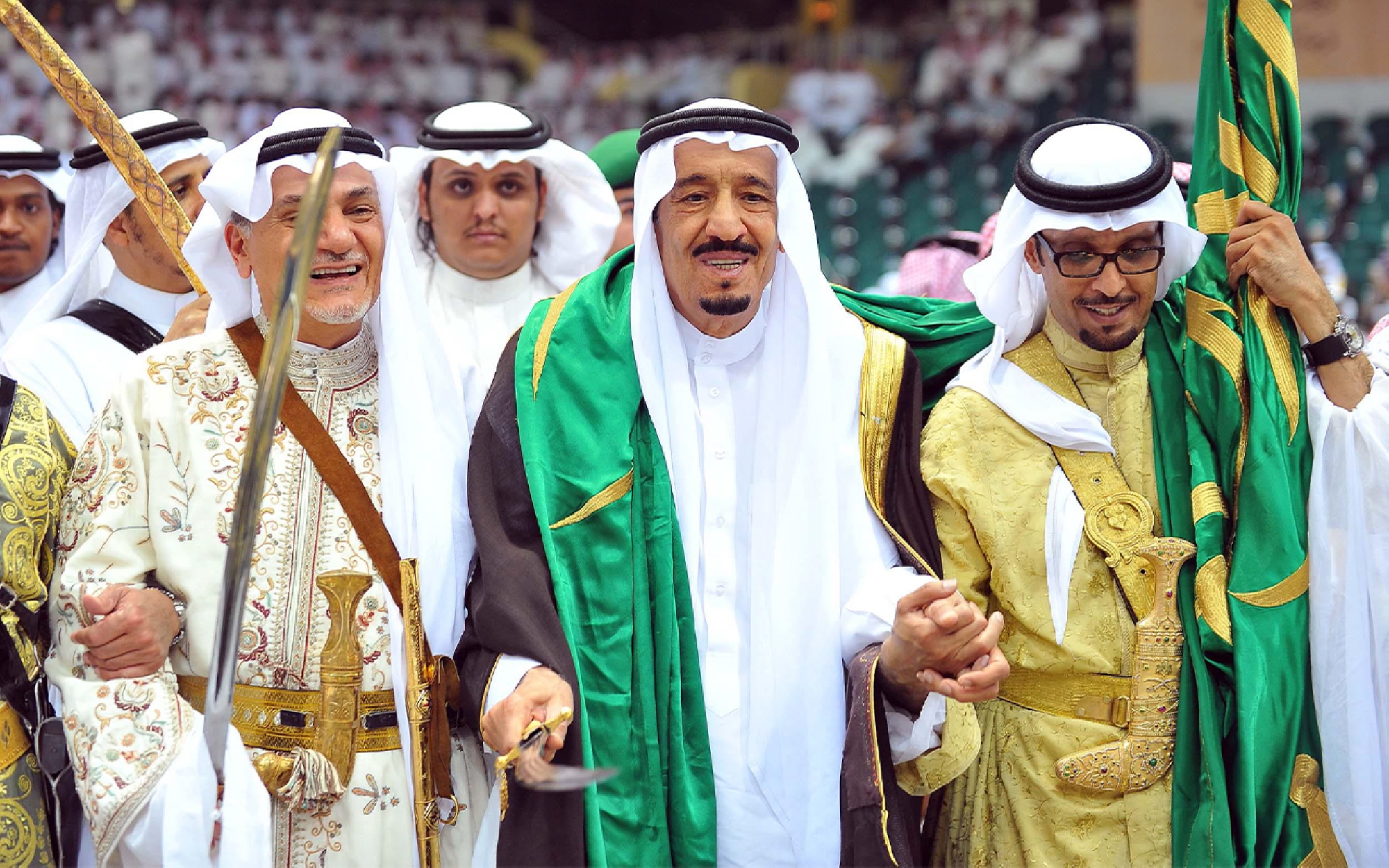
The Material Elements in the Saudi Ardah
Costumes of the Saudi Ardah
Performers of the Ardah in its traditional form wear the official Saudi Ardah costume, which retains the wearing of the Shemagh and Egal, along with a different set of robes. The Saudi National Center worked on preserving the imitation of traditional Ardah costumes, and its controls stipulate the necessity to adhere to them. This includes the official Ardah costume: the Thobe, Ghutra, Uqqal, Sayah or Daqlah, and the Farmaliah for the drummers, reflecting the diversity and variety of Ardah costumes, which include:
The costume of Murowdin
The Murowdin is characterized by having wide sleeves and loose fabric extending all over the body, covering it from the shoulders to the feet, and is worn over the traditional Saudi Thobe. The Murowdin is adorned with a sword, a dagger, and a belt for carrying ammunition and weapons.
Daqlah
This is a long, embroidered coat characterized by straight collars and six upper buttons. It is worn over the Murowdin. The fabric is heavy winter cashmere, and it is often open from the front and tied with two threads.
Farmliah
Known as al-Damer, it is a short coat with long sleeves, made of wool and embroidered with gold threads. It was part of the princes' attire before being designated for the drummers in the Ardah. It comes in several colors, such as green, red, and black.
Sayah
A garment made of light white fabric, it is subtly embroidered and barely visible. It is commonly worn by the companions of the kings in the royal court outside of the Ardah.
Zabon
This is a currently rare costume. It resembles the Daqlah in design but is thinner. It is also embroidered with gold threads and has two gimp buttons at the top near the neck, which are used for fastening.
Jukha
Known as al-Mahoud, it is made of broadcloth, comes in several colors like red and green, and is embroidered with gold threads. It is often worn by knights and dignitaries.
Weapons of the Saudi Ardah
The art of the Saudi Ardah originates from a war dance, performed to stir enthusiasm and display strength and endurance. Weapons were used to showcase power and armament, including the sword, dagger, pistol, and rifle. The Saudi Ardah art is rarely performed without one of these weapons, which are regarded as fundamental pillars within it. These weapons encompass:
The sword
It is the most important and famous weapon of the Saudi Ardah, consisting of three parts: the blade, which is preferred to be thin, sharp, and light for easy carrying and use (historically) during combat. In addition to the hilt or handle, the part where the sword is held. It is usually made from ivory or shell and decorated with gold or silver to prevent injury to the user's hand. Additionally, there is the scabbard, also called the sheath, which holds the sword. It may be coated with gold or silver and is hung with green or red ropes from which decorative threads dangle. It is used during the performance when there are not enough swords for all the performers. The most famous swords are the Indian and Damascene swords.
The dagger
It resembles a sword but is short and has a curved tip. It is considered an accessory of the Ardah costume, not a tool for physical performance in it. It is usually worn on a decorated belt called al-Mujanad al-Muzahhab, and it has many names, such as al-Qadeemi, al-Shalqa, al-Shibriya, and al-Janbiya. The Saudi National Center for Ardah recommends that the dagger and sword should not be sharp when used to perform the Ardah and that they should be formally identical to the historical weapons used in the Ardah.
Al-Fard
This is a compact, eight mm caliber pistol called al-Fard, secured on a leather belt. It is considered an accessory of the Ardah costume and is used in the physical performance when it is discharged into the air. The Saudi National Center for Ardah stipulates that firearms must be unloaded, devoid of any ammunition.
The rifle
It is one of the weapons used in the physical performance of the Saudi Ardah. It is pointed towards the sky or the ground during the Ardah and firearms are discharged. Several names have been given to it according to its types, such as al-Fateel, al-Muqma', al-Musba', al-Jift, al-Mashkok, Umm Khams Talqat, and the Enfield.
The rhythmic sound of the Saudi Ardah
Saudi Ardah poems
These are among the moral elements and pillars of the Ardah. The dance does not gain its significance without the lyrics that the performers of the Ardah sing. It starts with describing the clouds, the mount, or the call, then moves on to denigrating the opponents, and ends with pride in strength and bravery, not straying far from its original purposes as a war dance. A single poem does not exceed ten verses. The poet has the freedom to choose the meters and rhythms. These poems serve as historical references, documenting many past events, and generations continue to pass down and preserve these poems as a cultural and historical heritage. The Ardah has had prominent poets, both ancient and modern, such as Mohammed al-Aouni, Fahid Bin Duhayyim, Nasser al-Areeni, Abdullah al-Subai, Abdulrahman al-Bawardi, Abdulrahman al-Safyan, and many others.
Sequential vocal performance
The singing part of the Saudi Ardah starts with what is called the Hawrabah, where a person with a robust voice begins by reciting two or three verses, no more. This beginning serves as a signal for alignment and the start of the Ardah. Historically, it was an announcement of the start of war and a call for the warriors to line up. After that, the poet begins reciting the main poem, usually in Nabati poetry, which does not exceed ten verses from the long, medium, or short meter. Subsequently, the first line repeats this poem, while the poet turns to the next line to deliver the second part or the response, and the second line echos him. The drumming is synchronized with the recital of the verses. The Mawazir drums start after the main verse is recited, followed by the Takhmir drums, and finally, the Tathlith. The rhythm gains pace as the performers gather around the leader, raising their swords and chanting songs that reassert loyalty, support, and endorsement of this leader. This marks the end of the Ardah.
Drum rhythms in the Saudi Ardah
Drums are known as rhythmic musical instruments made from the wood of palm tree trunks, shaped into a frame that measures two to four cm thick, seventy-five cm in diameter, and fifteen cm wide. The skin of a camel, after being tanned and devoid of hair, is stretched wet over both sides of the drum. Its edges are tied using interlaced leather straps. The wooden frame is then drilled to insert a handle, which in turn is attached to a sturdy leather belt, allowing the drummer to carry the drum on their shoulder. The drums used in the Saudi Ardah are divided into two types: large drums called Takhmir drums and small drums called Tathlith drums. Each type has a different number of beats and distinct timing for striking.
During the performance of the Ardah, the Takhamir drums are hung around the shoulder using a leather belt, holding the handle in the left hand while striking the instrument with a thick stick in the right hand. This stick, about thirty cm long, is made of bamboo and curved at its other end. The drum is struck from the curved side, while slightly tilting the drum to the left. Simultaneously, the drummer moves his body to the right and left, then in the opposite direction, lifting the foot that is on the opposing side and slightly bending his knees downwards. The number of Takhmir drummers ranges from six to eight drummers. The greater the number, the more thunderous and majestic the Ardah becomes, as the multitude enhances the value and enthusiasm of the dancers.
The player of the Tathlith drums performs dance movements while striking the drums. They raise the left hand holding the drum and then lower it down and forward, with two consecutive jumps followed by squatting and then standing again. Therefore, the small drums must be lightweight for easy control. A piece of cloth is wrapped around the handle to prevent injury to the drummer's hand, and the frame is decorated with some tassels, similar to the large drums. These are colloquially called al-Raith or al-Danadish, as they carry a lot of al-Danadish and aesthetic decorations to create an aesthetic look when the drums are moved.
The large drums are struck with a single beat called Tafreda, while the small drums are struck twice and are called Muthaniyah. This is the reason they are named Tathlith drums because their two beats triple (in Arabic Tuthallith) the beat of the large drum. In the Saudi Ardah, a primary rhythmic pattern of binary units is used. The strong beats in the rhythm, known as Dum, are produced by striking the center of the drum with a bamboo stick. The Tak, which is played in the same spot, involves muting the leather surface of the drum with the same stick. The large drums are responsible for playing the basic unit of this rhythm. The controls of the Saudi National Center for Ardah stipulate that the drums must have two sides and that tambourines or any other instruments are not acceptable. The drums should be decorated with traditional ornaments.
Melodies of the Saudi Ardah
No melodic instruments are used in the Saudi Ardah, and it is limited to vocal performances of poems accompanied by drumbeats. Typically, Saudi Ardah poets use a simple melodic structure and maqams for the Ardah poem, often not extending beyond the pentatonic scale (typically using the first tetrachord), similar to many other folk songs worldwide that are known for their simplicity. The melody in Saudi Ardah does not exceed the fourth degree in the maqam used for Ardah, and sometimes the melody descends below the tonic degree by a semitone or two. If the maqam used is Sika, which is the most common and widely used maqam in Ardah melodies, the melodic line does not extend beyond the Husseini note (the fourth degree) and sometimes descends to the Rasd or Douka degree.
The limited melodic range in Saudi Ardah can be attributed to its complete reliance on the style of poetic recitation. The Ardah's origin as a war dance means that it requires strong dramatic recitation without elaborate musical embellishments. This style is commonly followed worldwide when composing national epics, powerful segments in classical musical compositions, and choral forms like opera and operetta.
Maqams of Saudi Ardah
The melody of most of the poems in Saudi Ardah relies on a musical maqam called Sika, which is an eastern maqam. The emphasis in Sika maqam is on the Sika note within the diatonic. Towards the end of the Ardah performance, there is an increase in rhythmic patterns as the performers move towards the leader while raising their swords. This maqam is distinctive to Arabic music and sets it apart from other musical traditions. It features intervals of three-quarter tone, which are unique to Arabic music and are particularly evident in maqams derived from the Sika degree. These intervals are a common characteristic in the melodies of Saudi Ardah, as well as in other maqams, such as Huzam, al-Maya, Rahat al-Arwah, 'Iraq, and Shu'ar (Musta'ar).
The Saudi Ardah flag
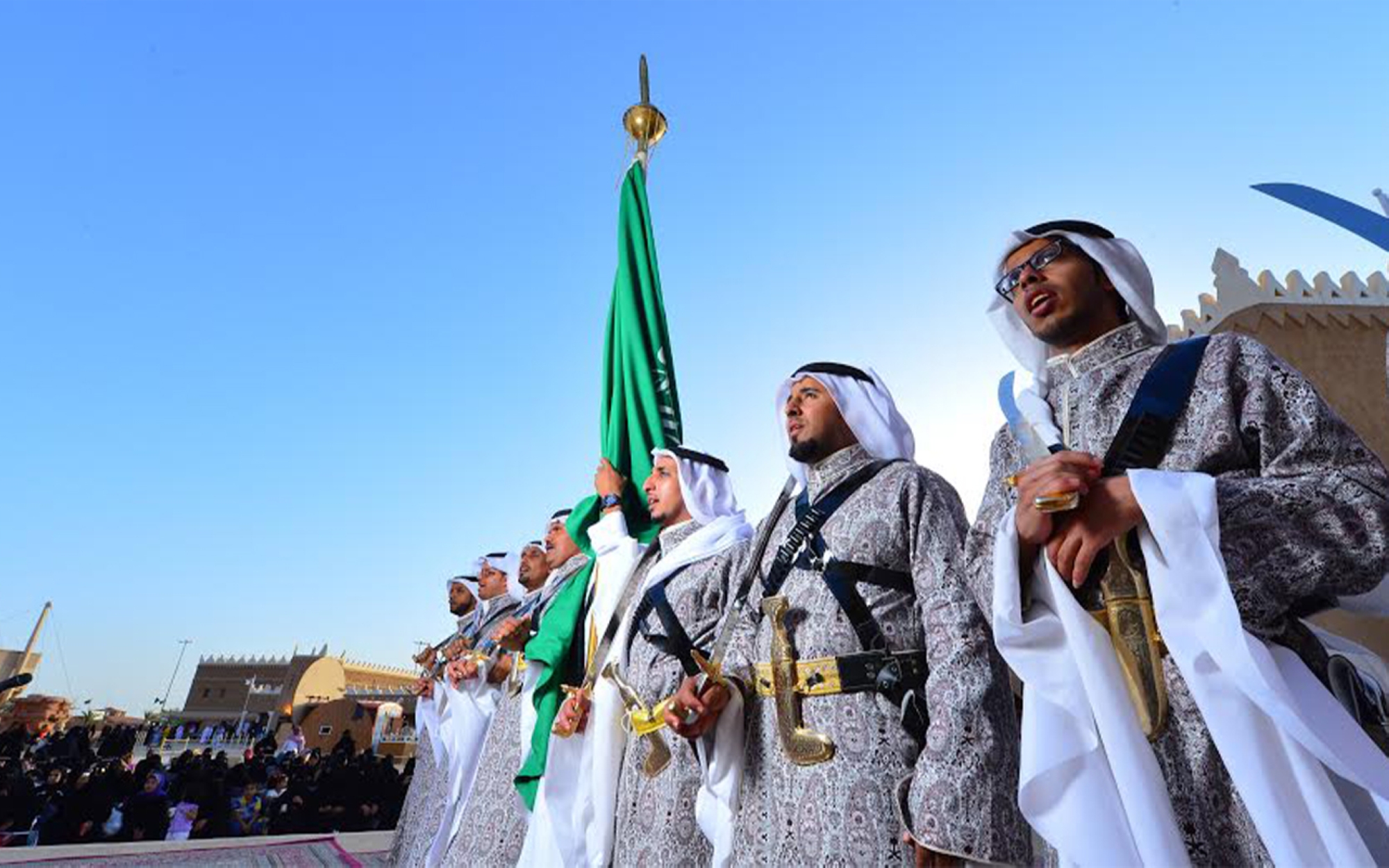
The performance of the Saudi Ardah is never without the presence of its flag, also referred to as al-Bairaq. It is an essential cultural component of Ardah performances, and its design is the same as the Saudi national flag. The flagbearer, who is referred to as Hamil al-Bairaq, takes a central position between the two groups in the Ardah: the group of war poem reciters and a group of drummers. The flagbearer stands prominently, occupying the highest position in the Ardah arena.
As per the controls established by the Saudi National Center for Saudi Ardah, the flag should have an appropriate size (with dimensions not less than 120x80 cm). According to the Flag Law and its approved regulations in this regard, the flag must not be old or wrinkled, but in good condition and with a suitable appearance. It should not touch the ground nor lowered to half-mast. The bearer must be committed to wearing the Ardah attire, physically strong, skilled in performing the Ardah, and quick-witted. The flagpole should be carried on the left side, with the flag placed on the right shoulder. The flagpole is topped by a finial and a spear.
The participants in the Saudi Ardah
The Saudi Ardah poet
The Saudi Ardah is based on poetic verses, thus poets are one of its most important components. They recite their lines to the performers, who then repeat them. In the poet's absence, the Muallim substitutes, delivering the poet's verse to the lines of performers. Among the most famous poets of the Saudi Ardah are Fahid Bin Duhayyim, Abdullah Bin Khamis, Mohammed al-Aouni, and others.
The flagbearer in the Saudi Ardah
Flagbearers in the Saudi Ardah are often those who have inherited the role from their fathers, who themselves carried the flag of unification during their participation in the wars and conquests of King Abdulaziz. Carrying the flag is considered an honor for them and serves as a tribute to their fathers.
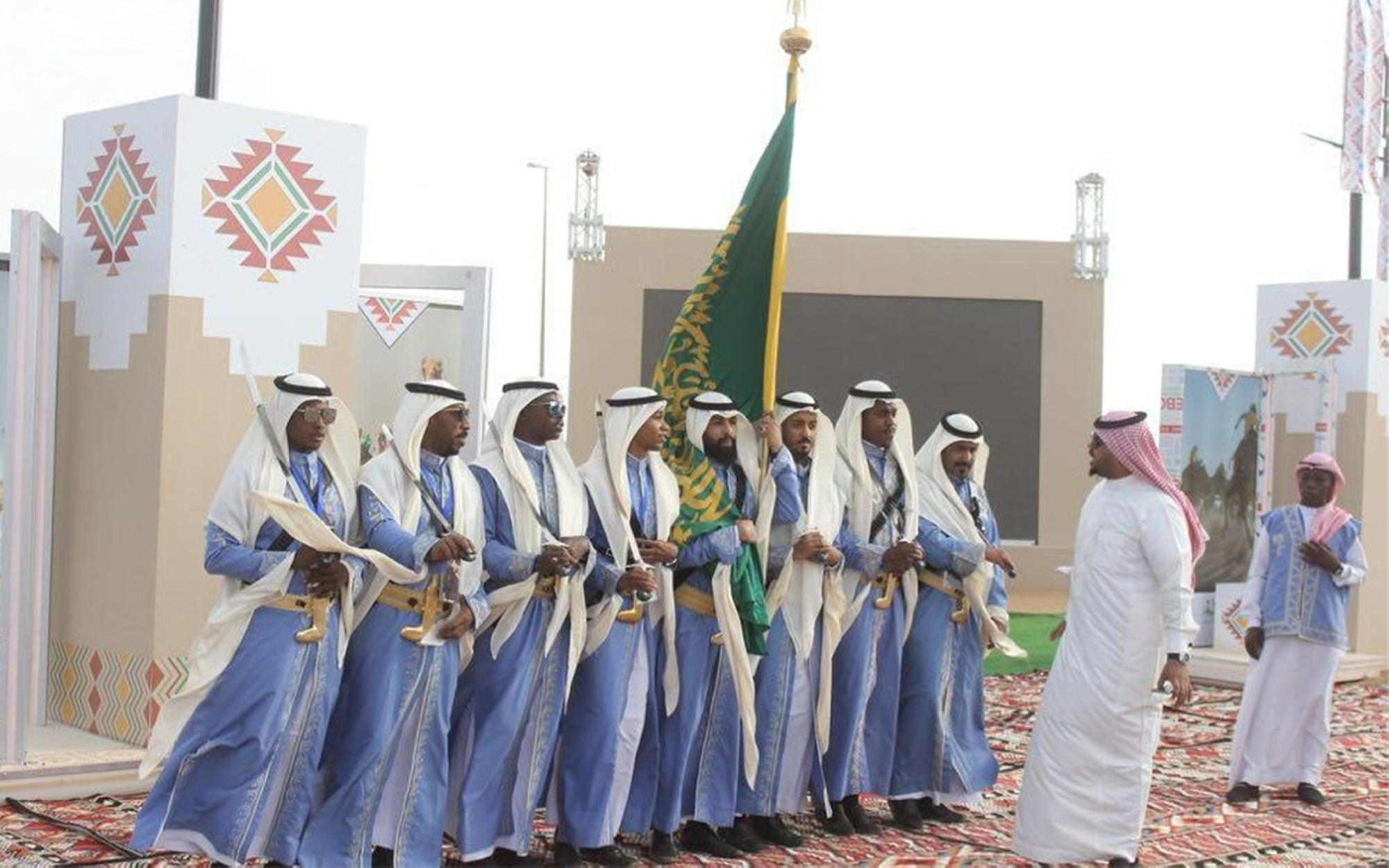
Group formations
The Hawrabah
At the beginning of the Ardah, also known as al-Bayshna, one of the chanters raises his voice with two or three verses of light war poetry. The others gather around him and raise their voices with the same verses, lifting the Muhawreb over their heads. This acts as a signal to start the Ardah, which in ancient times was a declaration to commence war.
Al-Deir
In formal performances, the Ardah takes the form of a sequence akin to a Masbaha, led by the leader followed by his brothers and sons, all performing a single movement, also known as al-Sabha.
Al-Khatimah
It occurs at the end of the Ardah, where the performers move towards the leader, raising their swords towards him and reciting specific verses that express loyalty and support for him. This is also known as al-Zamiya.
The lines of performers (Sufuf)
The performers of the Ardah are divided into two lines comprised solely of men. They either stand parallel to each other or one row shapes into a semicircle while the other aligns to complete a full circle. Performers often hold hands and execute the same movements to the same rhythm and pace, whether in the raising and lowering of the sword, lifting it high, or resting it on the shoulder. They also lean to the right and left, bending their knees in sequence. In echoing the leader, one line of performers recites one half of a verse, to which the second line responds with the second half of the poetic verse.
The cultural context of the Saudi Ardah
The Ardah in local culture
The Ardah is performed at celebrations, weddings, and national and cultural events, and is featured among other traditional dances at national forums, such as the National Festival for Heritage and Culture (Janadriyah). The Ardah is performed by two facing lines of men in the arena, each with his sword, except for the flagbearer, accompanied by the rhythm of drums and war chant poems. Leading the Ardah vocally are the chant of Abdulrahman Bin Safiyan in al-Wadiah War, Ya Habeel Al-Ra'i, renowned for its beginning Nahmad Allah Jat Ala Ma Tamanna, and the chant of Fahid Bin Duhayyim, Hin Hal al-Adat, known for its beginning Najd Shamit.
The Saudi and international Ardah
The Saudi Ardah was inscribed in 2015 as the first Saudi element on the Representative List of the Intangible Cultural Heritage of the Kingdom registered with the United Nations Educational, Scientific and Cultural Organization (UNESCO) for World Heritage. The Saudi Ardah became associated with the presence of the King at the Ardah night ceremony concluding the Janadriyah Festival, which has given it significant status and widespread fame. Most traditional Saudi dances were first performed in a military march or as part of a war chant. The Ardah, as a cultural heritage, transitioned over the course of Saudi history from the preparations for battlefields to the arenas of national celebrations.
Saudi Arabia's Efforts in Rooting the Art of Saudi Ardah
National Center for Saudi Ardah
The Kingdom established the National Center for Saudi Ardah, affiliated with the King Abdulaziz Foundation for Research and Archives (Darah), as an authoritative body for developing and reviving the Saudi Ardah heritage. The center aims to spread the culture of the Ardah domestically and internationally, train in the performance of the Saudi Ardah, and develop the art of the Ardah in terms of performance and form, while preserving this art's identity and essence. It also focuses on documenting this art, and finally, supporting those affiliated with this art and organizing its teams, performances, and participation. The center includes an advisory body from various related governmental entities, including the Ministry of Interior, Ministry of Tourism, Ministry of Education, Ministry of Culture, Ministry of Media, and King Abdulaziz Foundation for Research and Archives (Darah).
King Abdulaziz Foundation for Research and Archives (Darah)
The King Abdulaziz Foundation for Research and Archives (Darah) was established by Royal Decree No. (M/45) in 1972, to serve the history, geography, and intellectual and urban literature of the Kingdom in particular, and the Arabian Peninsula and Arab and Islamic countries in general. Its purpose is to collect and classify various historical sources, such as documents and others related to the Kingdom.
The Darah also publishes a special cultural magazine that serves its intended purposes. A library has been established, containing materials that aid male and female researchers in the subjects of the Darah’s interest. It has been tasked with documenting research and information related to the royal family, monitoring, and verifying everything published about the Kingdom, and correcting any errors that may occur.
The Saudi Ardah, a historical documentary study
It is one of the projects launched by the King Abdulaziz Darah to document the history of the Kingdom and perpetuate its intellectual and urban heritage. The project studies the Saudi Ardah from the era of King Abdulaziz to the present day, exploring various oral, manuscript, and pictorial sources. It examines its elements, traditions, poets, and their poems.
Saudi Ardah Costumes, a historical documentary study
It is a project launched by King Abdulaziz Darah to document the history of the Kingdom and perpetuate its intellectual and urban heritage. The project investigates the traditional costumes of the performers of the Saudi Ardah, including the dancers, drummers, and leaders of the line of performers. The study includes the design of the costume, its materials, manufacturing, and accessories, along with a historical tracing of the Saudi Ardah Costumes.
Folklore competition
The oral history of the Saudi Ardah initiative
It is an initiative launched by the Diriyah Gate Development Authority (DGDA) in 2021, aimed at preserving the historical heritage, reviving the Ardah poems, introducing its poets, and educating the community about this heritage art. This initiative falls under the initiatives for documenting oral history.
Saudi Ardah Exhibition
In 2022, the Ministry of Culture inaugurated the Saudi Ardah Exhibition in Riyadh City at al-Safat Square next to al-Masmak Palace, celebrating the Ardah as an authentic element of Saudi cultural heritage and highlighting its cultural value and its connection to the national identity. The exhibition featured a visual presentation of the Heda horse Ardah performed by King Abdulaziz, may Allah have mercy on him, as well as a display showing the evolution of the Saudi flag throughout the history of the Saudi state. It also included a photographic display of the kings of the Kingdom performing the Ardah on various occasions, highlighting the garments they wore and the swords they used. One of the exhibition's pavilions is dedicated to the craftsmen of the Ardah, focusing on the costumes used by the performers of the Saudi Ardah. The inauguration of the exhibition coincides with the launch of the Knights of the Ardah Institute, which aims to teach young people and those interested in learning the art of the Ardah and its principles under the guidance of professional trainers.
Diriyah, home of the Ardah
The DGDA launched the Diriyah, Home of the Ardah initiative in 2019. It is the first initiative of its kind in the Kingdom targeting the teaching of traditional Ardah to youngsters aged eight to sixteen years. The initiative is divided into two paths: The first path includes training courses to teach the art of Saudi Ardah by its most skilled performers. The second path involves awarding the Diriyah, Home of the Ardah Prize, which requires enrollment and attendance in training courses to be eligible for nomination and participation. The Theatre and Performing Arts Commission at the Ministry of Culture works on regulating all folk dances, including the Saudi Ardah.
Related quizzes
Related articles


